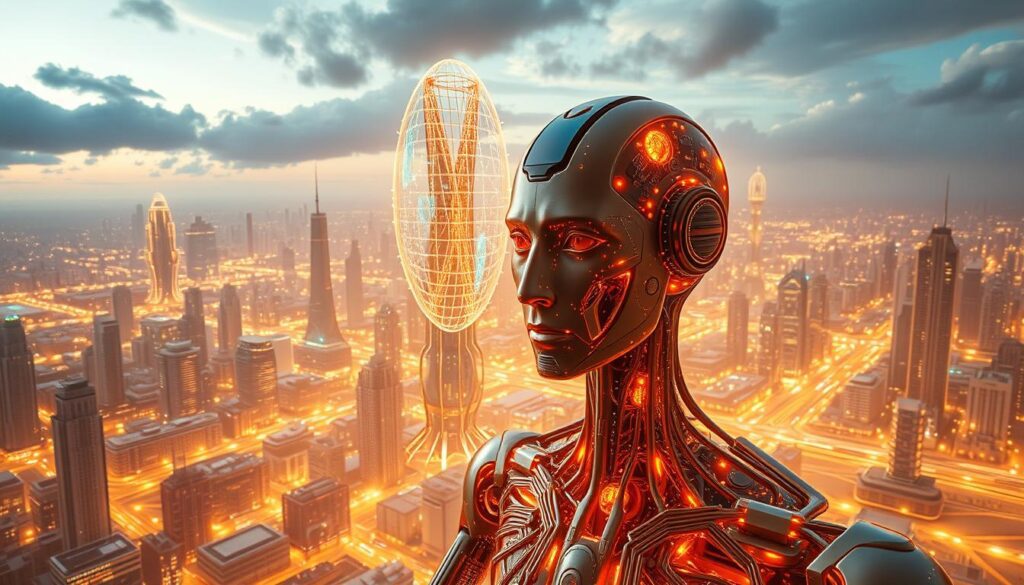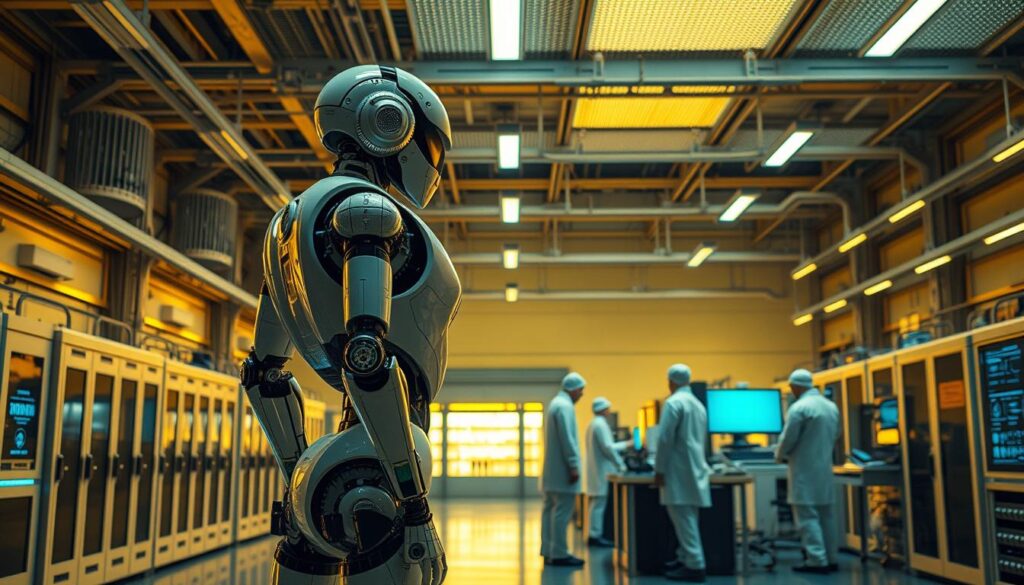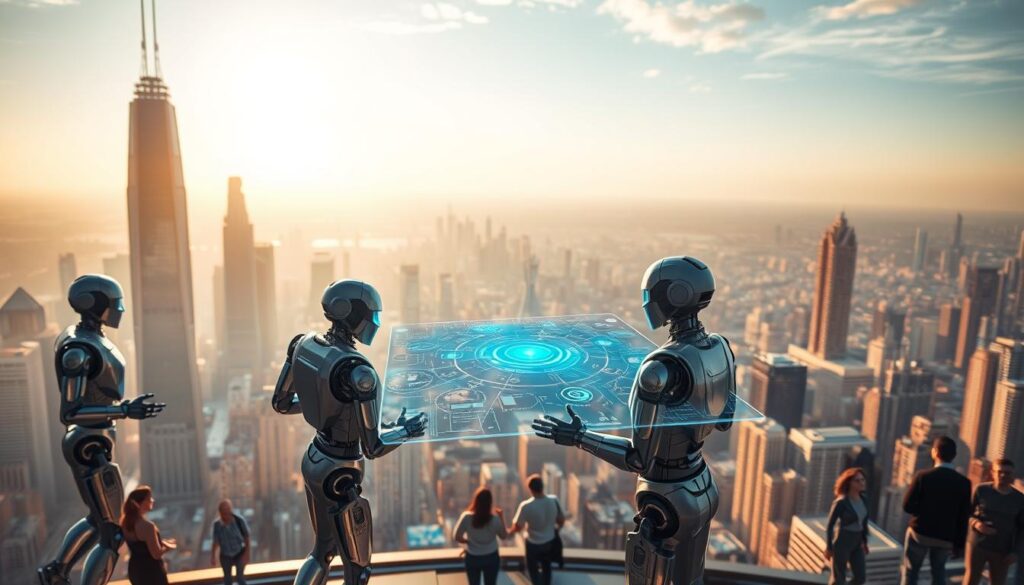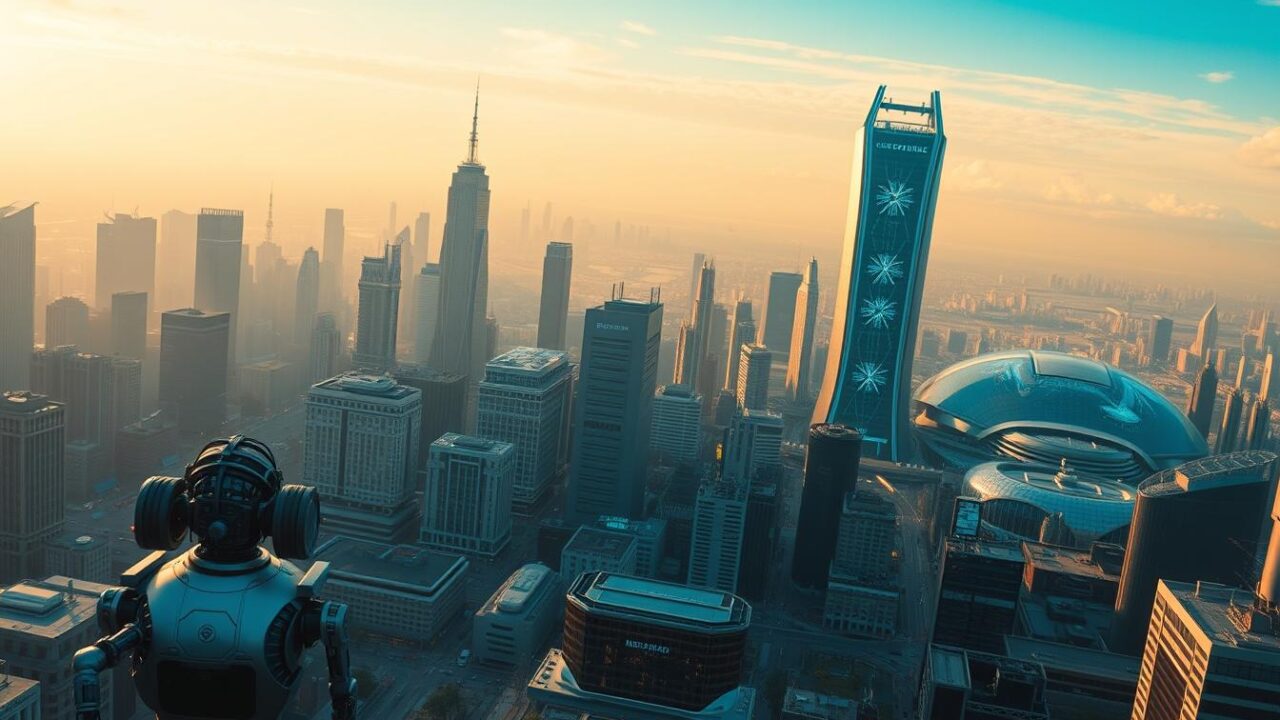Imagine if half of your work tasks could be changed by artificial intelligence in just ten years.
The future of artificial intelligence will bring big changes to our lives and the global economy. Experts predict AI will add USD 4.4 trillion to markets worldwide. This will change how we work, live, and use technology.
AI’s growth is set to be huge. Market analysts say it will grow from $150.2 billion in 2023 to $1,345.2 billion by 2030. IBM’s research shows 42% of big companies already use AI, and 40% are getting ready to start.
These numbers show just the start. By 2030, AI will change about half of the tasks done by 49% of workers worldwide. The top ten things AI will do post 2030 will go beyond simple tasks. They will touch every part of our lives.
AI will change healthcare and create new jobs. These changes are big and need our focus. Knowing about these changes helps us get ready for a future where humans and AI work together in new ways.
Key Takeaways
- AI will contribute USD 4.4 trillion to the global economy, marking the largest technological shift in modern history
- Market growth will surge from $150.2 billion to $1,345.2 billion between 2023 and 2030
- Nearly half of all workplace tasks will be influenced by AI within the next decade
- 42% of enterprise-scale businesses have already integrated AI into their operations
- Up to 30% of American jobs will experience significant AI-driven transformation
- The future of artificial intelligence extends beyond automation to partnership with human workers
The AI Revolution Beyond 2030: Setting the Stage

The world of artificial intelligence is changing fast. The market value shows where we’re going. It’s growing from £120 billion in 2023 to £1.1 trillion by 2030. This growth means big changes in how we work, live, and use technology.
Experts predict a big change soon. Quantum computing will make AI much faster. Big names like Microsoft, Amazon, and Google are already working on this. They’re setting the stage for huge advancements in AI.
Current AI Market Trajectories and Growth Patterns
AI is becoming more popular fast. Almost 40 per cent of companies are using generative AI. This shows they’re ready for the advanced AI of 2030. They’re making AI a key part of their business.
Shifting from Training to Inference: The Next Computing Paradigm
We’re moving from big AI models to practical ones. New models from IBM, Google, and OpenAI are smaller and more affordable. They work well on personal devices, saving money and keeping data safe.
The Democratisation of AI Hardware Beyond Nvidia’s Dominance
AI chip competition is growing. Nvidia is still leading, but others are catching up. They’re making chips for specific AI tasks. This will help more companies and developers, speeding up innovation everywhere.
Top Ten Things AI Will Likely Do Post 2030

The next decade will see huge changes thanks to AI. These changes will affect how we live, work, and use technology. They will be big steps forward, not just small updates.
From Digital Assistants to Life Partners: AI’s Ubiquitous Integration
By 2030, AI will understand text, images, audio, and video all at once. This means we’ll have friends that get us like never before. Netflix and Spotify are already showing how AI can make things more personal. But soon, AI will guess what we need before we even ask.
Humanoid Robots in Every Workplace and Home
Japan is already using robots to help the elderly. These robots will soon be able to do many things for us. They will:
- Do household chores on their own
- Help with hard work in warehouses
- Be our friends and give us emotional support
Complete Automation of Repetitive and Rule-Based Tasks
AI will change farming by using drones and robots. This will make farming more efficient. China’s iQIYI is also using AI to create new scripts. This shows AI will change creative fields too.
AI-Driven Medical Breakthroughs and Personalised Healthcare
Wearable devices will watch our health all the time. They will spot problems early. This will change how we treat illnesses, making it more about prevention than cure.
The Transformation of Human-AI Interaction

How we talk to artificial intelligence is changing a lot. Multimodal systems are making conversations between humans and machines feel more natural. They handle visual, auditory, and sensory data all at once.
This change is one of the biggest things AI will do by 2030. AI is getting better at understanding the world around us. Imagine talking to an AI that really gets what you’re saying, feeling, and thinking.
The entertainment world is on the verge of a huge change. AI-powered virtual influencers are gaining millions of followers online. Lil Miquela, a digital star, has worked with big brands like Calvin Klein and Prada. She makes a lot of money, even though she’s just a computer program.
By 2050, we’ll have fully immersive virtual worlds. These worlds will change based on how you feel and what you like. Imagine watching a movie that changes its story based on your reactions, or going to virtual concerts where AI performers talk to you personally.
This new way of interacting with AI isn’t just for fun. It’s changing how we work, learn, and connect with each other. It’s a big step forward for AI in the next 10 years.
Physical AI: The Rise of Humanoid Robotics
Artificial intelligence is changing, moving towards physical forms. Robots are becoming more than just tools; they’re becoming helpers that can move around like us. This change is big, showing how we’ll interact with machines in new ways.
Why Human Form Factor Matters for General-Purpose Robots
Our world is made for humans. Everything, from door handles to car seats, is designed for us. Humanoid robots are the best choice for general use because they fit right in.
The global labour market is worth £31. With 4 billion workers earning £8,000 a year, even a small part of automation could change the game.
Tesla’s Optimus and the Race for Mass Production
Tesla is at the forefront of making humanoid robots affordable. Their Optimus project aims to make robots under £16,000. At £4 an hour, these robots could replace workers earning £20, offering big savings.
“The future of artificial intelligence isn’t just about software—it’s about giving AI a body to interact with our physical world.”
Other companies are racing to make robots too. Toyota is working on robots for Japan’s ageing population. Chinese firms are investing in robotics, and European companies like Siemens are adding AI to their work.
From Warehouses to Homes: Deployment Scenarios
The timeline for humanoid robots is clear:
- 2025-2027: Warehouse and logistics operations
- 2028-2030: Manufacturing and assembly lines
- Post-2030: Domestic helpers and care assistants
Amazon shows how this works. In 2017, they had five humans for every robot. By 2024, it was two humans per robot. Their automated centre in Shreveport could save £8 billion a year.
The retail sector is embracing AI more. 71% of top retailers are using AI for promotions. Humanoid robots will soon help with customer service, managing stock, and running stores.
John Deere is leading in farming with AI tractors. Soon, humanoid robots will do tasks like picking fruit and checking plants. These jobs were too hard for machines before.
Economic Disruption and Job Market Evolution
The workplace is changing fast with the rise of artificial intelligence. ai predictions show that almost half of all jobs could be automated. This big change will affect jobs in many industries.
This shift is both a challenge and an opportunity for workers around the world.
Industries Most Vulnerable to AI Automation
Jobs like administrative roles, data processing, and routine manufacturing are at high risk. Retail cashiers, bookkeepers, and assembly line workers might see big changes. ai capabilities 2030 will impact their jobs.
Women workers are more likely to be affected, with 36% in roles that could be automated. This is compared to 25% for men.
Financial services, logistics, and customer service will also see big changes. Research shows that 85 million jobs could be replaced by AI. Up to 30% of jobs might be automated by the mid-2030s.
The Creation of New AI-Centric Roles and Opportunities
While some jobs may disappear, demand for STEM roles is expected to grow by 23%. AI and machine learning specialists will see a 40% increase in demand by 2027. New jobs are being created all the time:
- AI trainers and ethicists
- Human-machine collaboration managers
- Algorithm auditors
- Digital transformation consultants
Universal Basic Income: From Theory to Necessity
As automation speeds up, Universal Basic Income is becoming a real policy idea. With 11.8 million Americans possibly needing new jobs, safety nets are crucial. Some countries are already testing UBI, seeing it as a way to support people in a changing job market.
Beyond AGI: Redefining Intelligence Paradigms
The search for artificial general intelligence has been a big focus in AI research. But new technologies are changing how we see intelligence. Quantum computing is set to change AI, offering power that’s much greater than what we have now.
Quantum AI uses the strange rules of quantum mechanics, like superposition. This means qubits can be in many states at once. This could make AI up to 100 times faster. Companies like IBM and Google are working hard to make this happen, aiming to speed up AI tasks from years to hours.
- Knowledge distillation techniques that compress massive models into efficient, deployable versions
- Neural network pruning that strips away redundant connections whilst preserving accuracy
- Multimodal systems that seamlessly integrate vision, language, and reasoning capabilities
But there are still big challenges. Making quantum algorithms work needs hundreds of stable qubits. This is a huge task, but the benefits are worth it.
These changes aren’t just about more power. We’re seeing a big shift in how intelligence works. Instead of one big model, we’re moving towards smaller, special systems. This change means AI after 2030 will be very different, with new ways of working and thinking.
Healthcare Revolution Through AI Integration
The healthcare world is on the verge of a big change thanks to AI. AI is making diagnosis, treatment, and patient care better. Clinical misdiagnosis causes 10% of patient deaths and 17% of complications. This shows how important accurate medical technology is.
The global AI in medical diagnostics market is growing fast. It’s expected to jump from £1.04 billion in 2023 to £2.96 billion by 2028.
AI-Powered Drug Discovery and Development
Creating new drugs used to take 10-15 years and cost billions. But AI is changing this. Machine learning can quickly look at molecular structures and predict how drugs will work.
Companies like DeepMind and BenevolentAI find new compounds in months, not years. This is a huge improvement.
Predictive Medicine and Preventative Care
AI can spot over 1,000 diseases early, before symptoms show. It can even predict psychotic episodes with great accuracy. In India, AI-powered telemedicine brings healthcare to remote areas.
This helps fill a big gap in medical access.
Robotic Surgery and Precision Treatment
AI is making surgery better. Microsoft’s InnerEye technology cuts cancer treatment prep time by up to 90%. Robotic systems do delicate surgeries with amazing precision.
This reduces recovery times and improves results. By 2050, AI could help grow new organs and create prosthetics that feel like part of us.
The Geopolitical Landscape of AI Development
The race to achieve AI milestones has turned into a global competition. Nations are racing to be the leaders in technology. As we look at the future, understanding the global politics is key.
Countries are quickly setting their places in this new era. This is crucial for the future of AI.
National AI Sovereignty and Chip Manufacturing
The United States leads in AI development. In 2023, private American investment hit $67.20 billion. This is much more than China’s $7.80 billion.
American companies made 61 notable machine learning models last year. China made 15. The US’s lead comes from its control over chip manufacturing.
China, on the other hand, is focusing on patents. Between 2017 and 2023, China granted over 44,000 AI patents. This is nearly three times America’s 15,000 patents. China aims to secure its place in AI by 2030.
Intel’s Resurgence as America’s Chip Champion
Intel is playing a big role for America in chip manufacturing. The company is focusing on advanced manufacturing. This ensures Western nations have the AI hardware they need by 2030.
Global AI Arms Race and International Cooperation
The European Union launched its AI Continent Action Plan in April 2025. It’s committing €200 billion to compete globally. The Asia-Pacific region is expected to see the highest growth by 2030.
China is integrating AI with its Belt and Road Initiative. This is managing complex logistics networks. These moves are shaping the future of AI leaders.
Social and Ethical Implications of Advanced AI
The future of artificial intelligence raises big ethical questions. Experts agree on AI best practices, with 85.2% support. They also back safety steps like risk checks and audits.
The European Union leads in AI rules. It sorts AI into four levels based on risk:
- Unacceptable risk – banned apps that harm rights
- High risk – systems needing strict rules
- Limited risk – apps needing clear rules
- Minimal risk – safe AI tools
Keeping data safe is key for AI’s future. Zero-knowledge proofs and federated learning help. They protect data without sharing it, solving privacy issues.
Tools like the Word-Embedding Association Test spot AI bias. As AI evolves, fairness across all groups is vital. We must innovate responsibly, making AI better for everyone without widening gaps.
Preparing for the AI-Dominated Future
We are on the brink of a major change in technology. To get ready for advanced AI by 2030, we need to change how we learn, work, and make laws. With 42% of employers wanting to focus on AI training by 2027, it’s time to act fast. Skills become outdated in under five years, so learning continuously is key to keeping a job.
Essential Skills for Human-AI Collaboration
The future job market will need a mix of human and technical skills. Empathy, communication, and emotional intelligence will be more important than ever. These skills will work well with AI, not against it.
- Complex problem-solving and critical thinking
- AI literacy and data interpretation
- Emotional intelligence and interpersonal skills
- Creative thinking and innovation
Educational System Overhaul and Reskilling Initiatives
Universities are changing how they teach. Cambridge University is using AI to make learning more interactive. In India, Byju’s shows how tech can bring quality education to far-off places, making learning accessible to all.
Policy Frameworks and Regulatory Challenges
Creating policies that support innovation and protect workers is a big challenge for governments. The World Economic Forum says 75 million jobs might disappear, but 97 million new AI jobs could appear. We need careful rules and support to help everyone adapt to the AI future.
Conclusion
The future until 2030 looks bright with big changes in AI across all areas of life. Experts say AI could add $13 trillion to the world’s economy, a 16% boost to GDP. In manufacturing, AI could bring in $2.3 trillion, and finance is set to see 90% of trades made with AI.
AI is already changing our lives. For example, HSBC uses AI to spot fraud in transactions. Transport for London uses AI to manage traffic lights, making cities move better. These are just the start of AI’s big impact.
As AI agents get smarter, the market for them is expected to grow to $70.53 billion by 2030. This growth is driven by the need for automation and better machine learning.
There’s a strong base for AI’s growth, thanks to rules, privacy tech, and tools to check for bias. These steps are key to a future where AI is everywhere. Now, we must build AI systems that are strong and safe, and make sure everyone can use them.
As we move forward with AI, we need to be careful, keep innovating, and use AI for good. This will help everyone in the world.
Want to hire me as a Consultant? Head to Channel as a Service and book a meeting.

